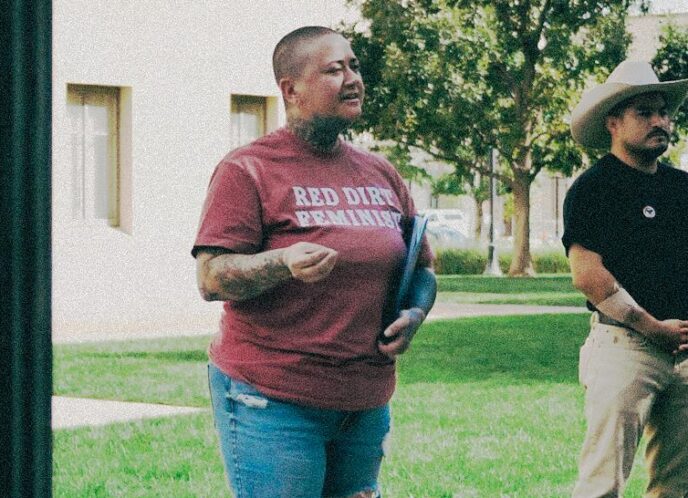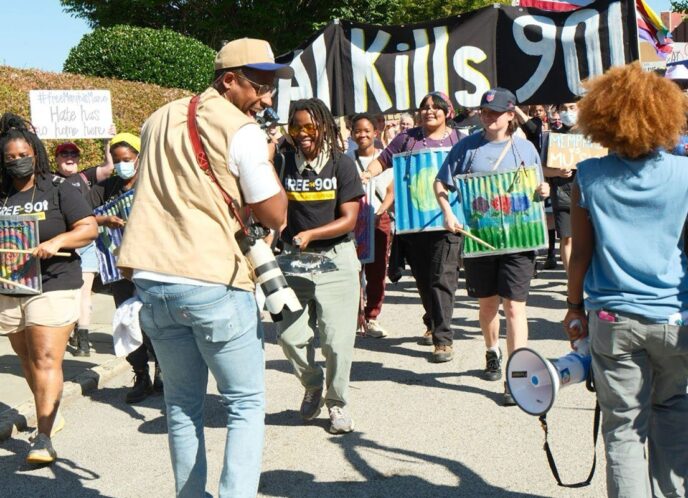In an effort to communicate in an accessible way that is in line with disability justice principles, the following is a plain language translation of MediaJustice’s new organizational strategy, Shifting Terrain.
Words to know:
The following is a glossary of common words used throughout our new strategy.
- Advocacy Group: Group that works to make media and technology fair.
- Media: Ways to share information with many people at the same time. Examples of media include:
- Internet
- Newspapers
- Television
- Social Justice: The belief that we should treat everyone fairly.
- Social Movements: Groups that fight for people who are not treated fairly. That includes people of color, poor people, women, and more. MediaJustice focuses on people of color.
- Technology: Machines, computer programs, and software. There are many kinds of technology. Some of the technologies MediaJustice thinks about are:
- Facial Recognition: Uses pictures or videos to tell who you are. An example is using your camera to unlock your phone.
- Social Media: Apps for connecting with people. Examples are Twitter and Facebook.
- Surveillance: Keeps track of where people are and what they are doing. An example is a camera that shows police what people are doing in their neighborhood.
What’s Our Goal?
- We want to make media and technology fair and equal.
- Media and technology can help us or hurt us.
- Fair media and technology will help make us all free.
- We are leaders in making media and technology fair.
- We share what we think media and technology should be like.
- We help people in social movements get skills to change media and technology.
Why is it Hard to Reach this Goal?
- A few big companies run most of our media and technology.
- The government works with these companies.
- These companies give money to politicians.
- Politicians make sure these companies keep making a lot of money.
- They control what kind of media people can see and who can use it.
- The government uses technology these companies make to hurt people.
- That makes it hard for social movements to make change.
- This system hurts people who are already treated unfairly.
- Social movements don’t always think about how to change media and technology.
- There are groups in Washington, DC who want to make media and technology fair. They are advocacy groups. But these groups don’t include everyone, like people of color.
- Advocacy groups and social movements need to work together. That is how we can make changes that will last a long time.
- It is hard to get the government to make changes that help people. We want them to stop companies from hurting people.
- With enough people, we can make things better.
- We need media and technology that focuses on justice and freedom.
- MediaJustice connects social movements and advocacy groups.
- We need leaders to show us how to make media and technology better.
- We want a future where social movements make our media and technology fair so people can be free.
- We think about people of color in all our work.
We have been doing this work for a long time. You can trust us to help change media and technology.
How Do We Reach Our Goal?
There are two ways we fight the big companies that run the media and technology:
- Connect social movements and advocacy groups.
- These groups will be stronger if they work together. We host meetings and other events for these groups. We help make change for people of color in media and technology.
- Do research and share resources.
- We want to change how people think about media and technology. We want them to think about justice for people of color. We help make new leaders by teaching them to think about media, technology, and race.
Facial Recognition: Uses pictures or videos to tell who you are. It can help people. You can use facial recognition to unlock your phone. It can hurt people. You can use it to track people.
Facial recognition does not work for everyone. It does a bad job recognizing women and people with dark skin.
The government uses facial recognition. They track people to arrest them or put them in prison. Sometimes, the government tracks the wrong person. Facial recognition thought they were someone else. This happens a lot to people of color. It is bad that the government uses facial recognition to hurt people.
Technology in Our Community: We use many technologies every day. Some technologies help us. The internet helps us:
- Get the news.
- Work.
- Go to school.
- Share our stories.
- Connect with friends.
Some technologies hurt us. One example is surveillance. Surveillance means keeping track of people. An example is a camera that shows police what people are doing in their neighborhood.
The government spends a lot of money on surveillance. They use surveillance in places where there are a lot of people of color. Places like:
- Detroit
- Baltimore
- Oakland
This hurts people of color. The government should spend money on technologies that help people instead.
Social Media: Apps for connecting with people. Some examples are:
Social media makes money by selling ads. They want you to use their apps a lot. They show you posts that make you emotional or angry so you spend more time on the app.



